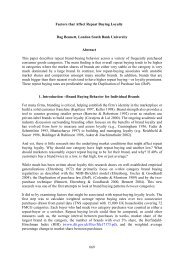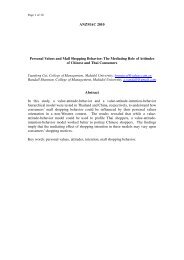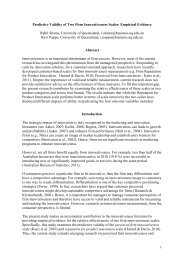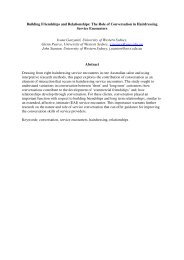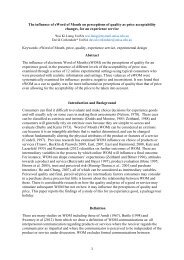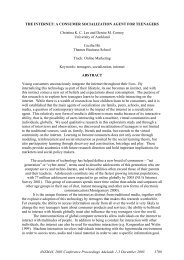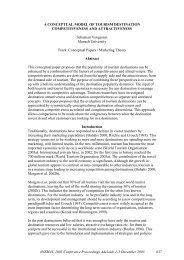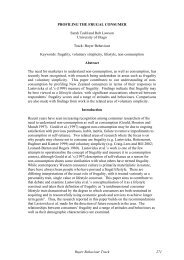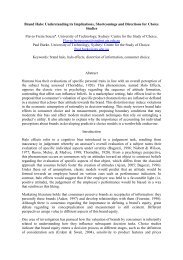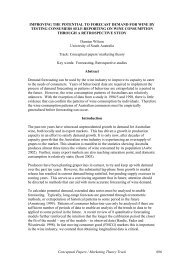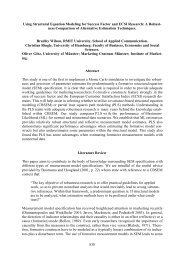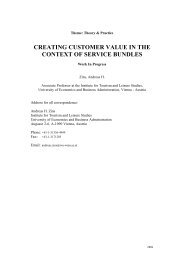amj Australasian Marketing Journal - ANZMAC
amj Australasian Marketing Journal - ANZMAC
amj Australasian Marketing Journal - ANZMAC
Create successful ePaper yourself
Turn your PDF publications into a flip-book with our unique Google optimized e-Paper software.
Book Reviews<br />
Students know what is relevant and it reduces their motivation<br />
when they are taught material that does not help them to solve<br />
marketing problems. By contrast, marketing problems are<br />
helped by answers to questions such as:<br />
What is the effect of different ad schedules on sales?<br />
How does music affect behaviour in stores?<br />
If customers are satisfied, will they stay?<br />
Which customers recommend most?<br />
What complaint handling techniques work best?<br />
What effects do loyalty programmes have?<br />
We address these questions in our research but then we fail to<br />
make sufficient use of our findings in our teaching. When<br />
marketing began, we had to borrow heavily from the social<br />
sciences and to teach from case studies because we lacked a<br />
sufficient body of findings that could be used. The emergence<br />
of more understanding of consumer behaviour, better knowledge<br />
of strategy outcomes, and useful mathematical models<br />
requires that we reassess the curriculum and squeeze out<br />
material that fails to educate or inform.<br />
There is also a case for a shift of emphasis to consumer behaviour.<br />
The dominant paradigm, which Schiffman et al. follow,<br />
draws heavily on conditions of the mind: attitudes, thinking,<br />
mood, culture. These have an explanative role but attitudes<br />
make no profits. A profit is turned from behaviour but the<br />
more behavioural emphasis is lacking from most consumer<br />
behaviour texts.<br />
These considerations lead to a different pattern for the marketing<br />
curriculum. The praxis remains but comes under pressure<br />
from the research fields dealing with individual and collective<br />
behaviour in markets. Criticism, doubt, new ideas and their<br />
challenge re-enter the field, as they should. For those who<br />
accept this analysis, the problem is then to implement the<br />
appropriate change. A sufficient number of marketing staff<br />
must state what is required in a more advanced curriculum and<br />
commission publication, using advanced PowerPoint support.<br />
We cannot leave decisions on the curriculum to publishers.<br />
As I went through the PowerPoint presentations, for<br />
Schiffman et al. I noted that each started with a quotation. I<br />
wondered when they would offer that ultimate opposition to<br />
80 <strong>Australasian</strong> <strong>Marketing</strong> <strong>Journal</strong> 9 (1), 2001<br />
consumer behaviour; getting and spending, we lay waste our<br />
powers (Wordsworth). They did not, but I quite liked I grow<br />
old ever learning many things (Solon), which seemed to<br />
capture the ennui of going through some of the material that<br />
practitioners never use, though I guess that this was not the<br />
intention of the authors. The quotation that echoed in my<br />
mind as I read the text was these are things that come not to<br />
the view, of slipper d dons that read a codex through . There<br />
is a codex in the current teaching of consumer behaviour that<br />
should be challenged.<br />
Robert East<br />
Kingston Business School, UK<br />
References<br />
Ajzen, Icek (1991) The theory of planned behavior. In Locke,<br />
E.A. (Ed.) Organizational Behavior and Human Decision<br />
Processes, 50, 179-211.<br />
Areni, Charles S. and Kim, David (1993) The influence of<br />
background music on shopping behavior: classical versus topforty<br />
music in a wine store. In McAlister, Leigh and<br />
Rothschild, Michael L. (Eds) Advances in Consumer<br />
Research, 20, 336-40.<br />
Craig-Lees, Margaret, Joy, S. and Browne, B. Consumer<br />
Behaviour, John Wiley, Brisbane, Australia.<br />
Dick, Alan S. and Basu, Kunal (1994) Customer loyalty:<br />
towards an integrated framework, <strong>Journal</strong> of the Academy of<br />
<strong>Marketing</strong> Science, 22, 2, 99-113.<br />
Donovan, R.J. and Rossiter, John R., Marcoolyn, G. and<br />
Nesdale A. (1994) Store atmosphere and purchasing behaviour,<br />
<strong>Journal</strong> of Retailing, 70, 3, 283-94.<br />
Kardes, Frank R., (1998) Consumer Behavior: Managerial<br />
Decision Making, Addison-Wesley.<br />
Reichheld, Frederick F. (1996) The Loyalty effect, Boston,<br />
HBS Press.<br />
Rossiter, John R. and Percy, Larry (1996) Advertising<br />
Communications and Promotion Management, New York,<br />
McGraw-Hill.<br />
Uncles, Mark (1998) Editorial: brand management in<br />
Australasia and the Far East, <strong>Journal</strong> of Product and Brand<br />
Management, 7, 6, 448-462.



